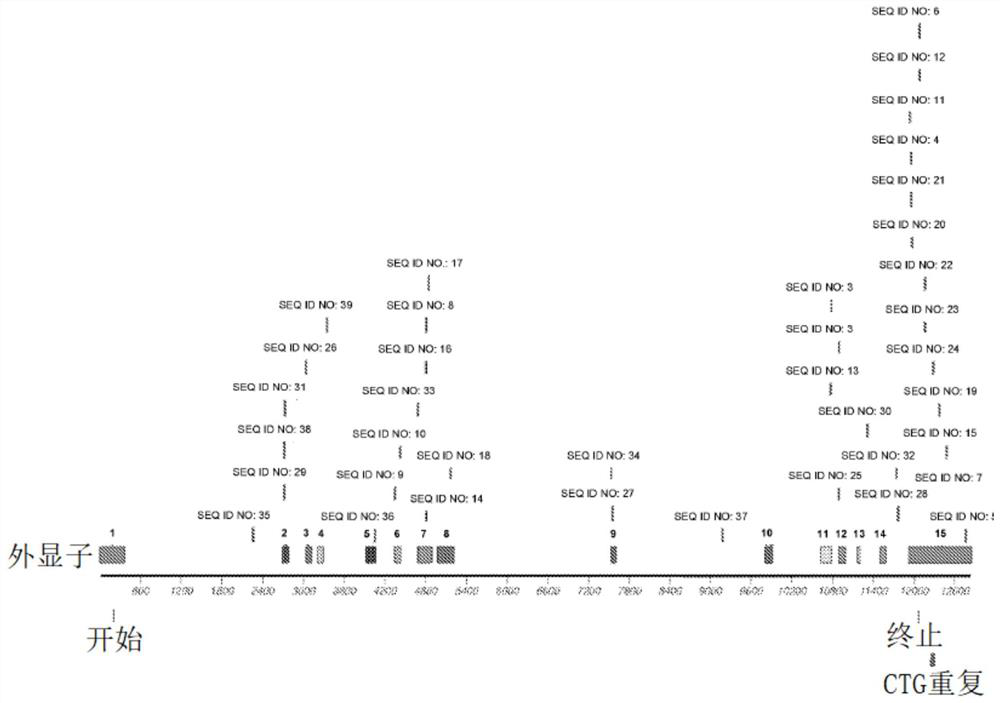Compositions and methods for reducing spliceopathy and treating RNA dominance disorders
An endogenous, exonic technology, applied in the field of composition of genetic diseases, can solve the problem of lack of successful treatment and mitigation
- Summary
- Abstract
- Description
- Claims
- Application Information
AI Technical Summary
Problems solved by technology
Method used
Image
Examples
Embodiment 1
[0202] Example 1. Development and evaluation of adeno-associated viral vectors encoding miRNA constructs for the treatment of RNA-dominantly associated diseases
[0203] Purpose
[0204] This example describes a series of experiments performed to characterize the encoding of LR Development and evaluation of rAAV vectors for miRNA constructs, the murine HSA LR Expressed in a mouse model of the RNA-dominant disease, myotonic dystrophy. Myotonic dystrophy (DM) is caused by the expansion of microsatellite repeats, which results in the expression of toxic expanded repeat mRNAs. Another RNA-dominant disorder, facial scapulohumeral dystrophy (FSHD), is caused by a reduction in the D4Z4 david satellite repeat, which leads to expression of the toxic protein DUX4 in adult muscle. The aim of the experiments described in this example was to develop AAV vectors encoding miRNA constructs targeting muscle DM and FSHD-associated mRNAs, thereby preventing muscle dysfunction and loss in affe...
Embodiment 2
[0219] Example 2. Treatment of Myotonic Dystrophy in Human Patients by Administration of Viral Vectors Encoding miRNAs Against DMPK
[0220] Using the compositions and methods described herein, one skilled in the art can administer a viral vector encoding an miRNA that anneals to a mutant DMPK RNA transcript containing an expanded CUG repeat region to a patient with myotonic dystrophy type I. and reduce its expression. The vector may be an AAV vector, such as a pseudotyped AAV2 / 8 or AAV2 / 9 vector. The vector can be administered by one or more of the routes of administration described herein, eg, by intravenous, intrathecal, intracerebroventricular, intraparenchymal, intracisternal, intramuscular or subcutaneous injection. The encoded miRNA may be a miRNA characterized herein, such as a miRNA having a nucleic acid sequence of any one of SEQ ID NO: 40-161.
[0221] Following administration of the vector, physicians can monitor disease progression and therapeutic efficacy by as...
Embodiment 3
[0222] Example 3. Treatment of myotonic dystrophy in human patients by administration of siRNA oligonucleotides against DMPK
[0223] Using the compositions and methods described herein, one skilled in the art can administer to patients with myotonic dystrophy type I siRNA oligos that anneal to and reduce expression of mutant DMPK RNA transcripts comprising expanded CUG repeat regions. Nucleotides. The oligonucleotide can have, for example, the nucleic acid sequence of any one of SEQ ID NO: 3-39.
[0224] Following administration of the oligonucleotides, physicians can monitor disease progression and treatment efficacy by assessing, for example, the concentration of correctly spliced mRNA transcripts encoding SERCA1, CLCN1 and / or ZASP using the RNA detection techniques described herein. Physicians can also monitor the concentration of functional SERCA1, CLCN1 and / or ZASP protein products produced from correctly spliced transcripts. Additionally or alternatively, the phys...
PUM
 Login to View More
Login to View More Abstract
Description
Claims
Application Information
 Login to View More
Login to View More - R&D
- Intellectual Property
- Life Sciences
- Materials
- Tech Scout
- Unparalleled Data Quality
- Higher Quality Content
- 60% Fewer Hallucinations
Browse by: Latest US Patents, China's latest patents, Technical Efficacy Thesaurus, Application Domain, Technology Topic, Popular Technical Reports.
© 2025 PatSnap. All rights reserved.Legal|Privacy policy|Modern Slavery Act Transparency Statement|Sitemap|About US| Contact US: help@patsnap.com



